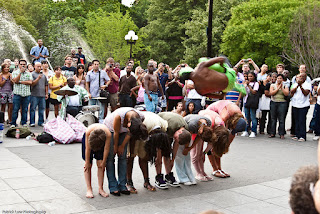.jpg) |
| NYCSBS Deputy Commissioner Elizabeth DeLeon speaking at the Grand Opening of Island Salad in Brooklyn. A business attracted through support from SBS' Retail Leasing Program. |
The Gateway BID is a graduate of the New York City Department of Small Business Services (NYCSBS) NYC Retail Leasing Program. As Senior Director of Retail Attraction, I was charged with designing and exeucting the program in its first year. Over the course of eight months in 2010-2011, together with Merchantville, NJ consultants JGSC Group, we led the Gateway BID staff through a comprehensive approach to retail attraction. The approach was something I brought to SBS from my time at LISC (Local Initiative Support Corporation), where in partnership with ICSC, we created a national program for community-based organizations. It was exciting and heady to apply these same principles across multiple communities in New York. Today, those investments are beginning to bear fruit - and the results are getting great coverage.
In Bed-Stuy, that includes the successful opening of Island Salad. Lisa Thompson, Deputy Director of the BID, was a participant in both the SBS program and the Coro Neighborhood Leadership Program where I also serve as Director. Both of these training programs helped reinforce the lessons on retail prospecting, and Lisa took these lessons to heart. On her sojourns to Harlem, she frequented Island Salad, getting to know the owner, even "friending" them on Facebook. She was also simultaneously beginning to develop relationships with local property owners, per our recommendations, and made sure to keep her fingers on the pulse of available properties coming onto market. The ability to connect a retailer she had cultivated with the right property was a matter of building those relationships and making the connections. It is a casebook study in how a BID should be managing tenant mix. [See Bed-Stuy Patch, "Island Salad Celebrates Grand Opening"]
Another excellent example of outcomes from the program can be found in the South Bronx, where WHEDCO participant Kerry McKlean has been able to reduce the vacancy rate by 8%, from 24%. You can read more about Kerry's efforts in this Crain's piece: "Former 'worst' area is on the mend: Shoppers and retailers rediscover Crotona Park East strip in the Bronx"
Kerry has applied the comphensive approach as well - using market data to identify opportunities, using that information to surgically go after retailers in the niche markets where she can meet three criteria - 1) consumer demand, 2) adequate space, and 3) community desire.
So, what is the approach? In a nutshell, there are four phases to the program.
Phase I. Diagnose your Market Gather data in an effort to understand your district and shoppers. This will help you develop a compelling story to share when marketing your district. That story should communicate your vision and brand clearly and concisely, while providing fact-based evidence of market demand. There are many caveats to these "facts", particularly in communities where census data does not reflect neighborhood change, or where a large office market skews residential income data.
That said, some of the most common fee-based providers of trade area market data are Esri's Business Analyst Online (BAO) and Nielsen Claritas SiteReports. We also advocate, when resource are available, collecting primary data to substantiate your case and better understand your market. Specifically, this includes comprehensive consumer surveys, which are a powerful mechanism to understand customer shopping habits. This valuable data serves as a checks and balances to census generated data. Not only that, but the specificity of the information cannot be beat.
Finally, you can't forget that ultimately, this work is about connecting retailers to available spaces. Take the time to develop an opportunity site inventory. While a comprehensive database is extremely valuable, it can be a resource trap if an exhaustive effort is made too quickly.
Phase II. Develop a Leasing Plan
Once you have your vision in place and your retail categories identified tell EVERYONE. Local business owners, property owners, brokers, etc. Communicate your Leasing Plan far and wide, market it, tell the press about it...get it out in the open.
Phase III. Generate Leads
Develop simple marketing material, identify prospects (there is a difference between prospecting for regional independents versus national retailers...), and make the call. There are subscription services to find some of this information - plainvanillashell.com is one - but much of the work, particular when looking for unique smaller retailers, involves hitting the streets, networking, shopping and eating your way through competitive districts in search of good retailers.
Phase IV. Be Proactive
Once you've made the connection, be ready to help negotiations between landlords and tenants, and once a deal is inked - CELEBRATE! Preferably over good food and drink! Building buzz is an intrigal step in this process. You never know who will read about your district's success, and who in turn will contact you seeking spaces for their business concepts.
This process is a wonderful way in which communities can be proactive in their retail leasing efforts. As a consultant I am often tied up in planning and strategy, so it is always a pleasure to celebrate these wonderful outcomes!
For more information on how this retail attraction program can help your community, contact info@larisaortizassociates.com









